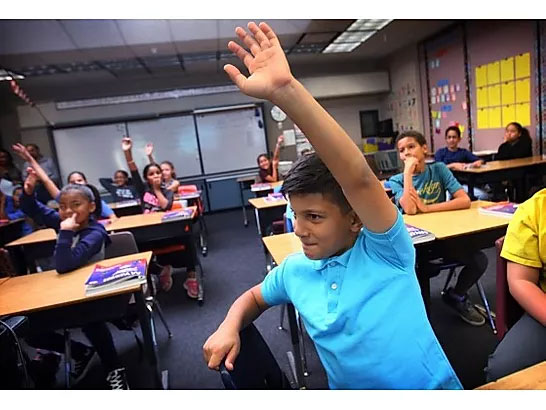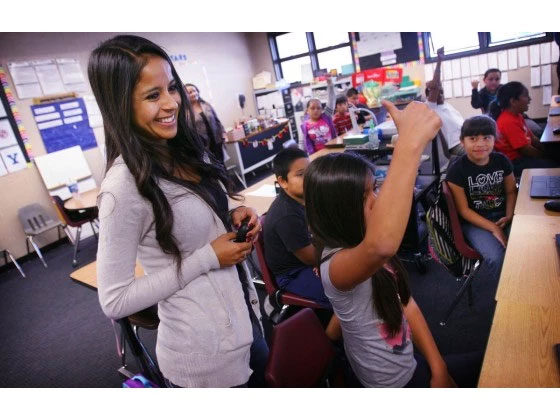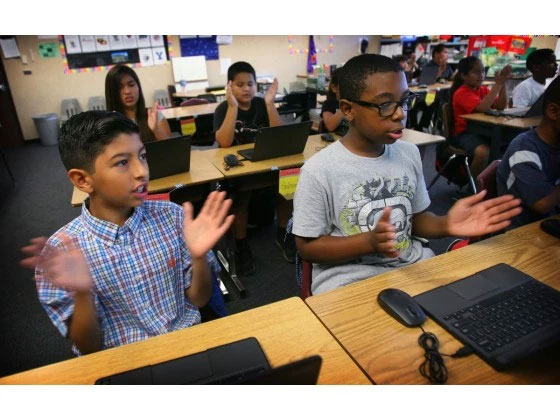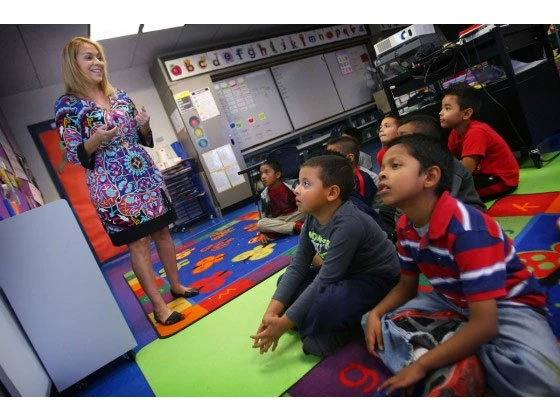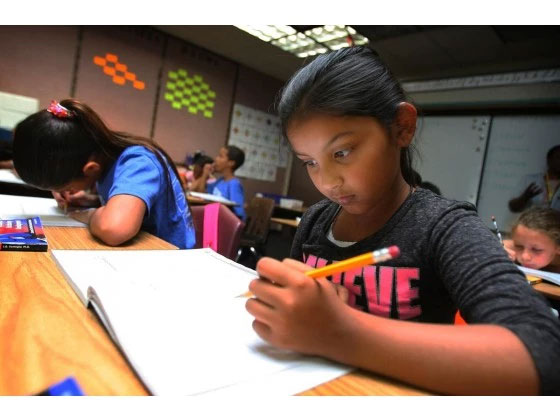The kindergartners at Box Springs Elementary School sat on a rug close to each other in front of the classroom, clapping in time to the vocabulary words on the screen before them.
Breaking down each word by clapping out each vowel is an element of a vocabulary learning program that started in the Moreno Valley Unified School District five years ago after its creation by a UC Riverside educator.
From there the program has spread to about 100 schools in seven states across the country – and school officials say its quality is proven by rising test scores.
As part of a recent lesson, teacher Marci Carver went over the word “barbershop,” showing a slide with pictures of one before she broke apart the words with a chart showing different components such as “ar,” “er” and “sh.”
A few students stepped up to the chart and pointed out parts of the words. Carver asked the class to explain the words, getting eager responses from several students. She finished with another slide with three drawings of barbershop scenes and asked students to describe them.
“First he went to the barber shop. Next the barber cut his hair. Last the boy’s hair is short,” said Emiliano Quiorz, 5, going over the pictures in front of his classmates.
Sitting in the back of the classroom, Linda Navarette, director and creator of Project Moving Forward at UC Riverside’s Graduate School of Education, smiled at the boy’s response.
The Harvard-educated researcher calls the vocabulary learning technique she devised the Rule of 3 – for rehearsal, analysis and production.
It involves daily lessons in which students learn new words by sounding them out phonetically and breaking them down by looking for common spelling and sound patterns. They’re taught to look for suffixes and prefixes and how to use them in sentences with the help of visual aids.
The technique emphasizes conversation so students answer immediately – often all at once – instead of raising their hands and waiting to be called on. Individual students are called to elaborate before the class breaks into groups to practice the words in conversation with one another before using them in reading and writing exercises.
“There’s an energy,” Navarette said. “I think they get involved in learning that way.”
The program launched at Hendrick Ranch and Armada elementary schools five years ago after Navarette approached Superintendent Judith White when she applied for and won a $1.9 million federal education grant.
It since has expanded to 17 schools in the district and is in 800 classrooms across the country, Navarette said.
The program aims to help English learner students, but in Moreno Valley it’s taught to all students in the participating classes, where they have many students from lower socioeconomic backgrounds who were also behind in their language skills, she said.
“We’re finding that learning and knowing vocabulary is the big difference between those who succeed in school and those who don’t,” she said.
More than 90 percent of the students in the program met or exceeded state benchmarks for the annual California English Language Development Test – surpassing the state target of 62 percent.
Students are tested for to see if they fall into in five proficiency levels – from beginning to advanced – and are expected to go up one level each year. Some Moreno Valley students have gone up two proficiency levels, the 2016 results show.
At Seneca Elementary – the flagship site used to demonstrate the effectiveness of the program – students saw a 10-point gain in state English test scores.
Deborah Johnson, a fourth-grade teacher at Seneca, was an original teacher in the program and now trains other teachers as the program expands.
“We have students who speak in complete sentences now,” Johnson said. “They fell in love with words, and they connect those words to their lives.”
During one lesson, Johnson taught her fourth-grade class the word “generate” and asked them to use the word by explaining how they would generate interest in a family car wash. She got several responses.
Verdi Rizvi, 9, suggested creating a video that is “fun and enthusiastic.” Taylor Jones, 9, added they should have some music and family games. Another student, Waheed Awad, said they should create a sign with the address so people could find the car wash.

